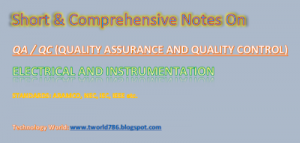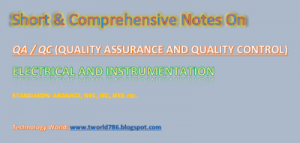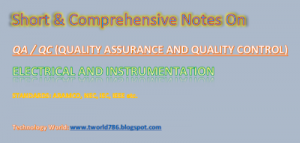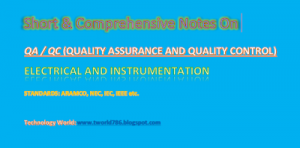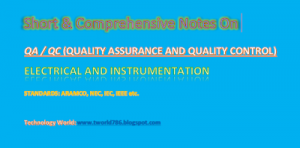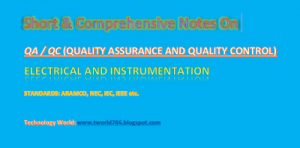QC Aramco Standard Electrical and Instrument Question Answers
1. Explain procedure related to Quality Control?
Ans: The quality procedure is the series of steps taken to maintain the quality standard as per the adopted standard and other specific.
2. What do you know about NEC, NEMA VE1, NEMA VE2, NEMA RN?
Ans: NEC – National Electrical Code earlier used to be published under the statutory body of NFPA since 1897, from 2005 edition it is categorized as an internationally accepted method inspection procedure guidelines covering all most all the field related to Electrical, Instrumentation and Communication Engineering.
NEMA VE1 – National electrical manufacture association VE1
NEMA VE2– Deals with cable tray installation specification
3. What are the articles refereed during carrying out the following activities?
(1) Grounding. (2) Installation of cable Tray. (3) Fire alarm System Installation. (4) Installation Instrument Cable Tray etc,
Ans: (1) Grounding Article 250 (Chapter IX for instrumentation), (2) Installation of cable tray
Article 392, (3) Fire Alarm System Article 760, Installation of instrument cable tray article 727.
Article 392, (3) Fire Alarm System Article 760, Installation of instrument cable tray article 727.
4. What is Duct bank?
Ans: It is concrete poured structure with conduits laid inside by maintaining certain specified elevation as per the requirements for the laying of cable through this enabling protection, support and safety to the cable.
5. What would be the thickness of the top layer of a Duct Bank and color?
Ans: 5 mm and Red Dye.
6. What is the purpose of using paint/dye on top layer?
Ans: To give an anticorrosive protection, top layer painting is provided.
7. What are types of conduits used in electrical and instrumentation wiring circuits?
Ans: Rigid Metallic Conduit (RMC), Intermediate Metallic Conduit (IMC), Rigid Nonmetallic
Conduit (RNC).
Conduit (RNC).
8. What are the differences between a JB (Junction Box) and Terminal Box?
Ans: The purpose of JB (Junction Box) is used as a linkage between one or more inlet and one or more
outlet. Whether terminal box has inlet on or more but out let may be one for earthen or it may not be. JB can be used in between the routing for providing support and extra opening but TB is used as Termination means at the end of the routing.
outlet. Whether terminal box has inlet on or more but out let may be one for earthen or it may not be. JB can be used in between the routing for providing support and extra opening but TB is used as Termination means at the end of the routing.
9. What is ‘termination’ related to construction industry?
Ans: Termination is widely used term in case of construction industry. For electrical and instrumentation work this is used for make the routing as a complete one.
10. What is the impulse line?
Ans: It is line rather tubing connection made from the source (flow pipeline or vessel) to the transmitter (sensing device) to create the feasibility to the transmitter to sense the flow and to generate equivalent electrical signal to get the indication of the status of the system working.
11. What is the check list?
Ans: It is the list of sequential activities to be performed by any QC Inspector during inspection of any activity performed by construction. It is made separated with distinguished activities for each construction activity.
12. What is punch list? What is requirement of making a punch list?
Ans: It the list generally identified as RA 60B, which is used at the time of finalization of any activity. Means every activity should be stamped with a final and foolproof documentation which shows the clear evidence of the all completed job. It is always signed by QC to ensure the maintainability of the quality aspect of the job performed.
13. What is the role of QC during shut down?
Ans: QC has the major role to be played at the time of shut down. It is the responsibility of QC to officially hand over any completed project to the client with all the documentations to be provided with the real completed project. This including the records of completion (activity wise) areas with limitations as shown in punch list, the processing and final inspection test report of the actual functioning of the project by making it operational.
14. What do mean by Hazardous and Non Hazardous area?
Ans: The area classification is done as per area wise risk involvement (environmental). The area with maximum percentage of risk in function any system is known as hazardous area (NEC Art 500 – 510).
15. How are the hazardous and non hazardous areas classified?
Ans: Hazardous and non hazardous areas are classified according to the classifications and zones.
16. What is the Expansion joint? What should be the standard gap maintained in expansion joint?
Ans: It I the breathing space provided to accommodate the expansion of horizontal cable tray to suit with different climatic condition by maintaining a standard length wise distribution.
According to NEMA VE2 it is after every 20 meter with a spacing (expansion joint) of 25 mm to be maintained. It sometimes differs, but should not be more for the horizontal length of the cable try.
17. How the metallic cable trays grounded?
Ans: Metallic cable tray shall be bonded at both end points and minimum of every 25 meter local ground grid or ground electrode or to structural steel bonded to local ground grid or ground electrode.
18. How the metallic conduit grounded?
Ans: grounded at both end points by bonding to grounding conductor, grounded metal enclosure or to grounded metal cable tray by using approved grounding clamps.A grounding bushing must be used with PVC coated conduit.
19. How many connection points required for equipment ground?
Ans: a)
For equipments like (motor, generators and transformers) which operated at 1000 v or greater shall have two connections to supplementary electrode.
For equipments like (motor, generators and transformers) which operated at 1000 v or greater shall have two connections to supplementary electrode.
b) If the motors, generators and transformers operating at nominal voltage 480 v shall have a minimum of one connections to supplementary grounding electrode.
20. What type of conduit is used in duct bank?
Ans: Duct bank consists of either hot-dip galvanized rigid steel with PVC coated or PVC conduit, encased in concrete.
